#country is not a loved genre these days particularly for leftists
Explore tagged Tumblr posts
Text
it's called cowpunk
BUT THERE'S NO FUCKIN'. PLAYLISTS ON YT THAT ARE SONG COMPILATIONS
IT'S ALL PLAYLISTS PUT TOGETHER USING THE FUCKIN' PLAYLIST FUNCTION AND MY BRAIN WON'T LET ME TRY THOSE OUT FOR SOME ARBITRARY REASON
please for the love of god i want to listen to punk country music. i've secretly always loved the way that country music sounds but the lyrics are just so terrible so often that i've stayed away from it for the sake of my sanity
but punk as a genre has never failed me so COWPUNK, which is the punk subgenre in country music, should be fucking amazing. but there's like 5 playlists and brain is too scaredys to look at them. screaming crying throwing up taking my brain out and picking it apart with tweezers until i can figure out why those aren't good enough so i can problem solve
#byrd chirps#cowpunk#music recs please#i think the whole thing is just too new#and the safest-feeling way for me to explore new genres is with those playlists that are a single video all put together#with the songs listed by timestamp#and ideally there'd be lyrics somewhere but that's just a bonus#and apparently none of those exist on youtube#WHY GOD WHY do i have to enjoy obscure genres#i don't WANT them to be obscure#sure if they're popular they might get commercialized#(that's probably why punk doesn't do very well is because it often commercializes poorly no matter the quality)#but then at least there'd be PLAYLISTS#and no im not gonna make a playlist are you kidding me?#i can't fuckin work a video editor! and i don't have the spoons for a yt channel yet that shit is terrifying#because i stg the moment any subscribers find out i care about fat activism it'd be off with my head!#idk maybe we could incorporate some country music into what we're doing? we could be folk cowpunk?#you know with AKA#but i'd have to discuss that with the others and i don't want to keep messing with the band and like#country is not a loved genre these days particularly for leftists#because of the whole tendency towards christonationalist lyrics yknow?#so i make no promises and hold no hopes for that#gotdamn that's a good line i gotta use that more often#anyways.
4 notes
·
View notes
Text
the batfam's fave music genres:
Dick: pop girlie through and through - big abba fan, loves britney and tswift, seeing yoncé live is the best thing that ever happened to him
Jason: musical theatre nerd - he looooves newsies so much, used to dream abt being a broadway star; occasionally dabbles in folk music and leftist protest songs (he knows the lyrics to both Solidarity Forever and The Internationale)
Tim: 2000s emo/pop punk guy - loves mcr and green day, simple plan for when he's feeling particularly angsty, nirvana when he's angry at the world
Steph: extremely eclectic tastes, her fave playlist goes from skrillex to taylor swift to cardi b to disney to daft punk to tupac to
Damian: big k-pop fan - loves bts (but would never admit it ever) - but mainly listens to arabic rock
Duke: he's a boyband guy through and through - nsync, backstreet boys, one direction, jonas brothers - if they're a group of men making silly pop songs, he's into it EDIT: have been informed that duke canonically likes heavy metal that critiques the american prison/judicial system (which is so fucking cool)
Cass: heavy metal, death metal, gothic metal - her favourite band is Nightwish
Bruce: he likes 'old' music - frank sinatra, billie holliday, the andrews sisters, johnny cash - and, somewhat incongruously, Marina Diamandis
Others:
Babs: she loves opera and has a particular fondness for prokofiev and wagner (inherited from her dad, they used to go to the Gotham Opera together)
Selina: latin pop - gloria estefan, enrique iglesias, ricky martin, selena - as well as reggaeton and salsa (she loves to take bruce salsa dancing bc he's a pretty good dancer and can throw her around a bit)
Clark: he loves country music - johnny cash, dolly parton (he met her as superman and got her autograph), shania twain, orville peck - but he mainly listens to podcasts bc he's a nerd (affectionate)
Talia: like damian, she enjoys arabic rock but also arabic folk music, bollywood music, and frank sinatra (like selina, she likes to take bruce dancing except it's swing dance instead of salsa)
#jay talks#batfam headcanons#batfam music#bruce wayne#dick grayson#timmy drake#jason todd#steph brown#duke thomas#cassandra cain#damian wayne#barbara gordon#selina kyle#clark kent#talia al ghul#batcat#brutalia
174 notes
·
View notes
Text
Mobile Suit Gundam: The Origin. Fuck war, love comics.

So I’m making my way through Yoshikazu Yasuhiko’s Mobile Suit Gundam: The Origin and like I’ve seen Yaz’s work before. I have the first volume of Venus Wars--but it just didn’t click for me. MSG: The Origin tho is goddamn sorcery on the page. You need to know this first off, you don’t need to know anything about Gundam to read this. The whole thing is this is the book retelling the story that started it all but like Yaz’s from the heart version. And two volumes in, which is like...1000 pages of comics, and this is a masterpiece.
I’m mostly going to talk about the art, but story wise, military stuff is generally not my bag. Unfortunately, it’s a genre that is grossly popular in American comics, not just in straightforward military stories, but superhero comics as well. Too often these heroes have design updates that are all too happily to enlist heroes whose past models leaned more heavily into daredevil circus performers or wrestlers. You know the look. When your favorite hero goes from tights and a cape look to body armor looking shit everywhere. War on crime right? And then these companies on their film side have all kinds of connections to the military industrial complex--hell these companies often employ ex-military, or in some notable cases ex-CIA to write the damn books. And when you couple that with how interested the military has always been with warping people’s brains to keep the war machine humming(they once put acid in a whole town’s water supply just to see what would happen!) it’s quite unnerving! So besides being extremely anti-war in practice, I’m also pretty tin foil hat when it comes to seeing the edges of the military in pop culture, particularly when the message is like “look how cool this is!”
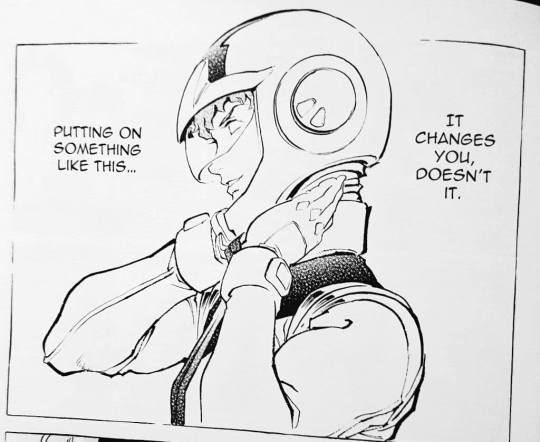
Which as a sidebar is one of the things that makes the Aubrey Sitterson GI Joe thing complicated to me, because like...I don’t think GI Joe is a good thing, and I don’t believe leftists should be getting their pay pushing paper for something that could not BE more military industrial. Like let's make kids think how cool being a soldier and going to war is--and then those kids grow up, and what a surprise we are in like ten wars that we know about, and will be for forever--and you get this kind of brainwashing that turns Kapernick trying to say “hey, maybe cops should stop shooting black men” into a debate about “respecting the flag” because the NFL is in bed with the military….agh. I hate it. I hate it all. From Operation Condor, the firebombings of dresden, hiroshima and nagasaki, the genocide of the american indian, fallujah, Abu Ghraib, our complicity in Saudi atrocities in Yemen and Qatar...we are not the good guys of history! We kill for empire, but our empire isn’t colonies, it’s more war. Our chief export is war. And I would love to expatriate to a country that doesn’t have these values, but I don’t know if even then I could shake that shit from my stomach. And even more insidious than our war is our financial arm, our banks and investors who have killed as many people with pens as any soldiers with guns. We are an empire of atrocity!
So when I see military comics, or cop comics, it just reminds me that I live in the most warlike country of the last 100 years, and all of those innocent people that are caught up in our bombs, and the way we turn whole regions into chaos to serve our ends and make more money--my relative prosperity as an American is built on the bodies and bloodshed of innocents the world over. I mean why is America what America is? It’s because WW2 basically moved europe's wealth to the US, and then we spent it on more bombs and we stepped in not because of any real moral thing--we stepped in because england owed us too much for us to let them go down. We as a country became a world superpower, the world superpower, through war profiteering and slavery. That’s a huge aside, but I’m saying, I fucking hate war. And maybe find ways to not contribute to more of those sort of comics? But more than that in an aesthetic sense, the codes for military in American comics are so bland and it seems half the time to justify not having to do interesting character designs. So surely there is a better fit for someone like Sitterson who has the politics I do, I think, than writing war comics to a patriotic pro-military audience, so I wish him the best, but fuck GI Joe. (And as an aside aside, if it were Frank Miller and not Aubrey Sitterson with the controversial opinion that book isn’t getting dropped--these companies only do these things as financial calculations, and if you are a big enough cash cow you can say or do whatever you want in comics for the most part but if you aren’t--you better protect your neck because these companies don’t have your interests in mind. And we live in stupid times) So I can fuck with Gundam because 1) it hates war as much as I do. And 2) they’re not trying to make everything look like utilitarian military shit. They’re about looking goood while they are hating war. The story is really rich, background characters positively radiate and each have their own character which comes to the fore at different parts. In some respects, Amuro Ray haunts this comic like death, because he’s the end of so many terrific characters that you really grow to love, and the Federation cause is somewhat murky at best, as is their exploitation of kids like Amuro. I kind of think Yaz does my favorite faces in all of comics, unseating Jose Munoz:
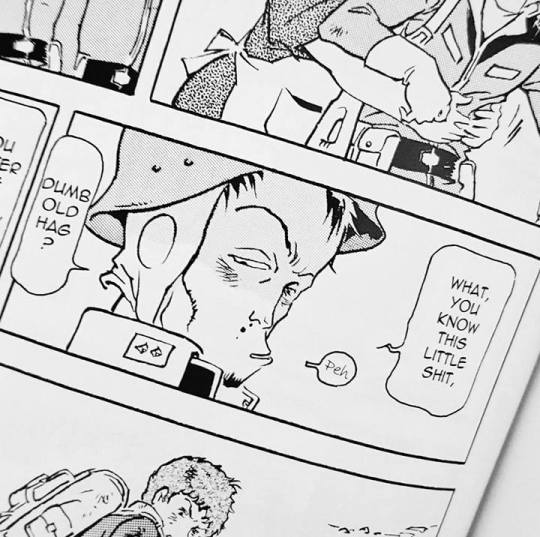
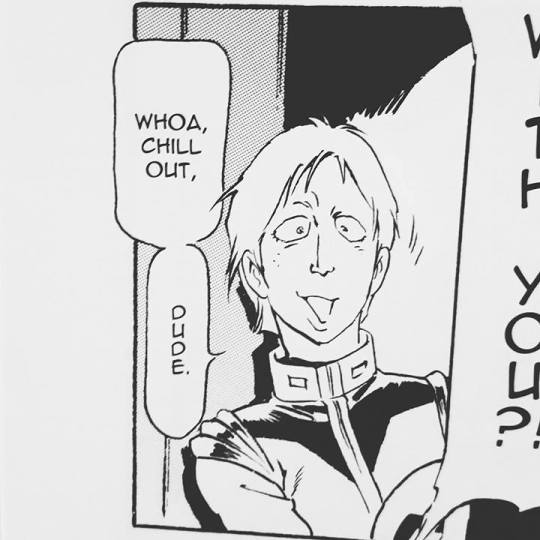
This kind of caricaturing is really lovely for a story this rich and dense, because you get so much just from how a character looks and the faces they make, and it’s quite appealing to look at I think. There are characters you fall in love with just because you want to see Yaz draw their face again. The range of expressions he has in the toolkit is amazing to me. Yaz’s style in general to me is like magic. Lines don’t connect, and it’s like he can just shift around these minimal set of lines and accomplish anything on the page. It’s like he has a set number of lines that he’s working with on every page, and he just dips his brush into the page and waves it around and those lines bend and contort into perfection. He’s one like Kirby where he kind of just sits down at a page and the images come out of his brain.
It’s not overly rendered, but it still is textural and inky. I think this also has my favorite lettering in comics. I don’t know who was responsible for it in english, but I love the obvious care that went into varying the lettering, and just how gentle and elegant it is. It probably was just a font in a computer--but it doesn’t FEEL like that, which is cool. Oh also Yaz watercolors various pages in the book, and they are almost all stunning. I’m planning to read his Joan of Arc book which is all watercolored, so that should be interesting. But I think what comes across more than anything reading these books, because of not only the comic, but the production value of the books themselves--the hard cover, the essays at the back, the slick pages, the thoughtful lettering--what comes across from stem to stern is that these books are a labor of love and passion in a way that you would not expect from the retelling of a decades old giant anime franchise!
Hideaki Anno said in his essay in the first book: “And I sense a certain good grace. He decides to draw Gundam--well known to the masses as a premier franchise of the plastic model and anime industries--not from weariness, not as expiation, nor to return to his roots, but in earnest as a work of his own” and I think he’s absolutely correct. There’s a love and attention to every inch of these books that is really inspiring to behold whether as an artist or in whatever you do to fill out your days--seeing something, anything, done by a master, with care and concern is a special thing to behold. I mean I don’t know for sure that Yaz actually gives a shit about this book--but that’s what comes across on the page. It comes across that he cares about these lines, about these stories, vividly, and even more surprising, the people whose charge is getting the work out to others, they seem to care just as much, so what you get is a very very special book.
In some ways, these dueling masters, Char and Amuro Ray, also express this concern and care. At one point Char loudly criticizes Amuro Ray for his lack of style. And while Char’s vanity, his secrecy, his romantic rogue ideal is extremely alluring, and any scene he’s in, I’m pretty glued to the page--he’s like Harlock or Queen Emeraldas. We don’t have these kind of artist villains in American comics for some reason. The closest I’ve seen was Ron Wimberly’s Prince of Cats which has characters who besides their bloody monstrous ideas, consider style to be important.
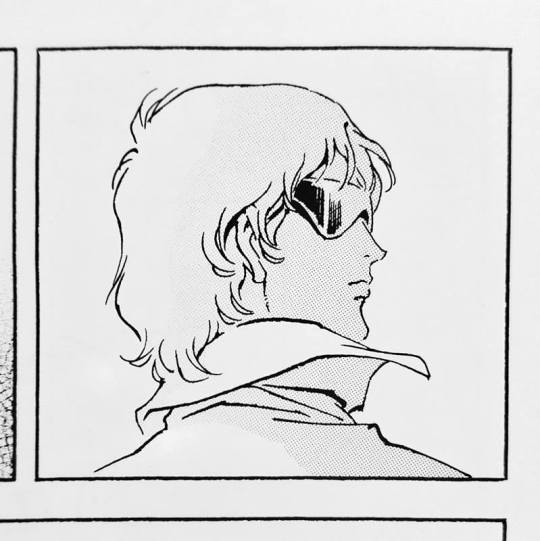
But even with all of that going on with Char, I’m surprisingly drawn to Amuro Ray--who is a character even without watching the original Gundam series(something I’m planning to rectify this winter--trying to finally knock out all the Gundam I’ve put off for years) that you just kind of know even without ever knowing why. He’s a legend. Like Luke Skywalker. Even his name when you say it, you feel like you are speaking the name of a god. But he’s a punk kid who has been dragged into this war against his will, and is desperately trying to balance doing the right thing, and keeping his identity. I love that sometime he just refuses to go out in the Gundam which puts Ltg Bright in these particular binds(Bright might lo key be my favorite character in the series weirdly, for how he kind of morphs through being a snotty prick, to being in over his head, to being someone capable of real genius creativity. I’ve been watching Iron Blooded Orphans which is a Gundam series about child soldiers and is really brutal and depressing, and Orga is kind of like Bright mixed with Char.) His mercurial nature speaks to the nature of his art versus Char. Amuro Ray belongs to the fickleness of inspiration, so because of that he’s not really reliable, but when he shows up he’s capable of things Char isn’t, moments of improvisation and grouchy genius that are the linchpins of the romantic appeal of the series.
Versions of this character archetype I feel usually are supposed to be incompetent or dumb to those around them, but their conviction carries them, they have the most will--but in Amuro Ray’s case, he’s just an asshole. The despair of it all, which is never lost on Amuro is that whether he does something, or doesn’t do something, people are going to die and it’s going to hurt. And knowing that, that in the end horror is inescapable, and that death is undefeated--like what do you do? How do you function? What do you choose when there are no good choices? Char is a little different, because his aim is revenge. Which that side of Char that he hides behind his rogue’s grin, and devilish acts is really stunning when it first comes out in these early books. He’s so careful to let that out, and when it does, you’re like “oh man, Char isn’t playing the same game the rest of you are”. Agh. It’s soo good. Comics like these keep the fires going. There’s an infinity of them out there to be sure, but nothing makes me happier than a truly great comic. Those comics that years after you remember the experience of reading them, where you were, what music was playing. A great comic is a great lover. It won’t last forever, though there’s a LOT of this book still for me to read--and I get in this mode where I both want to just inhale the whole comic as fast possible, and I don’t want this experience to end. This is that sort of thing. Which should be evident, since I bothered to write about it, haha. I could never just review comics. I’m like Amuro Ray with comics criticism, I need the right situation to be compelled to climb in and do it. I don’t fundamentally love writing comics criticism--but when I experience something great, I have to talk about it and write about it. Comics like these affirm everything about being involved with comics for me. Check it out, see if you feel the same way.
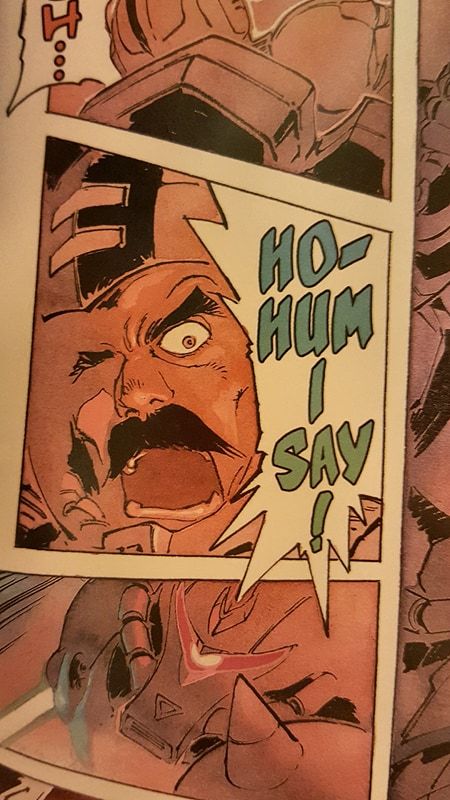
If you liked this essay, and want to see more like it, subscribe to Sarah Horrocks’s Patreon. For as little as a dollar a month you can help a comic topic in need get the coverage it deserves.
49 notes
·
View notes